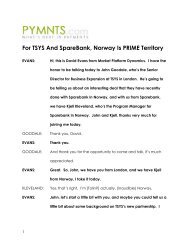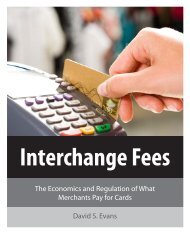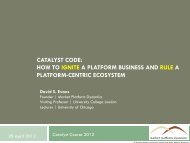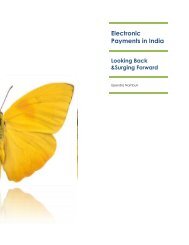Lydian Payments Journal - PYMNTS.com
Lydian Payments Journal - PYMNTS.com
Lydian Payments Journal - PYMNTS.com
You also want an ePaper? Increase the reach of your titles
YUMPU automatically turns print PDFs into web optimized ePapers that Google loves.
payments, purchases, and cash advances. 13 In this example, the promotional rate balance disappears in six<br />
months, rendering it useless at that point even if the offer gave the promotion for a full year. After month<br />
six, the purchase balance rapidly declines leaving almost all of the customer’s balance at the cash advance<br />
rate which is typically much higher.<br />
The Evolution of “Fragmentation”<br />
With fragmentation, a uniform price or quality is broken into smaller pieces for the purpose of creating<br />
signals. Unlike the traditional literature on signaling where information is naturally fragmented and the<br />
signal is used to improve information, 14 in a peacock market fragmentation is actually an information<br />
reduction strategy. A firm manipulates a product design to shroud underlying pricing or quality while<br />
presenting prominently the factors optimized to draw in consumers.<br />
Credit card pricing has be<strong>com</strong>e dominated by prominent (but misleading) price signals <strong>com</strong>bined with<br />
shrouded revenue enhancement mechanisms to <strong>com</strong>pensate for the cost of these signals. While a uniform<br />
price — or at least not highly disparate price — over time is more informative and more consistent with<br />
product cost, the price of credit cards over time is intentionally fragmented into two general <strong>com</strong>ponents.<br />
The first is a highly prominent price signal that consumers are known to disproportionately attend to,<br />
while the second is a less obvious but larger <strong>com</strong>ponent of price that is adjusted to make up for losses in<br />
the signal price.<br />
Perhaps the archetypical example of fragmentation for any industry could be the credit card teaser rate. In<br />
a perfect market with rational consumers using a fixed, reasonable discount rate, there would be no reason<br />
to price products at 0% for the first 6 months or year, and then a much higher interest rate thereafter. It<br />
makes little sense based on the cost of lending or any other economic rationale. APRs on credit cards were<br />
at one time uniform. The primary purpose of disaggregating the near term interest rate and charging a<br />
separate price appears to be to create a powerful price signal. But this is not an information‐enhancing<br />
signal as the traditional economic literature suggests. Instead, unnecessary <strong>com</strong>plexity is introduced to<br />
create a signal that is lower than the long‐term cost of credit. Due to cognitive constraints and limited<br />
attention, the information level digested by the consumer is probably lower due to the creation of the<br />
signal. This is what the signal is intended to do in peacock markets. It creates a <strong>com</strong>pelling impression of<br />
low prices despite the fact that the total price paid by the typical consumer is much higher. In some cases<br />
13 In this scenario, the consumer starts with a $1,000 promotional balance and makes purchases and cash advances of<br />
$100 a month each, while making payments in an amount equal to this monthly activity ($200 a month).<br />
14 See, e.g., Spence, “Signaling in Retrospect.”<br />
© 2009. Copying, reprinting, or distributing this article is forbidden by anyone other than the publisher or author.<br />
33








